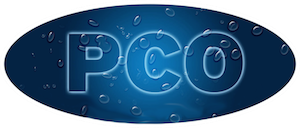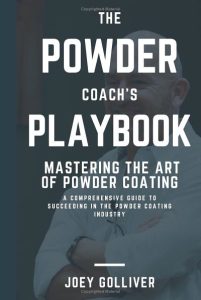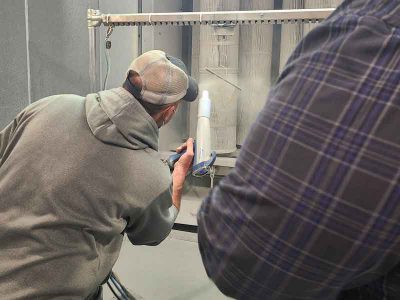Powder cure control is so important! The excitement builds as the start up procedure of a new powder finishing system begins. Months of planning and hundreds of thousands of dollars went into the project. Finally the washer is heated, the oven is started, and the conveyor begins to move. Minutes seem like hours in anticipation of the first coated test panels to emerge from the system. As the sample panels exit the oven they are allowed to cool before quality testing begins. So far everything looks great, the finish is glossy and smooth.
On closer examination however, the panels have failed the simple impact test (ASTM D-2794). Additional testing was performed by cross-hatch adhesion (ASTM D3359) and confirms the coating did not complete the full cure cycle.
![]()
What could have been the problem?
- Was the oven’s atmospheric temperature too low?
- Was there uneven heat distribution within the oven?
- Was there poor air-flow or venting of the air inside the oven?
- Was the part in the oven for enough time to reach the proper temperature to allow cure?
The answer could be yes to one or all of the above. The cause of the problem is clearly under cure of the powder coated finish. The finish did not receive enough heat energy for the correct amount of time to properly cross-link and cure.
But how do you know what to do to correct the problem? The answer is oven temperature profiling.
As soon as the construction of a powder coating convection oven is completed, adjustments are made to maximize the efficiency of the equipment as a unit. This is done by adjusting the operating parameters of the oven based upon a temperature profile obtained from a thermal profiling instrument.
Thermal profiling is the recording of time and temperature throughout a thermal process – most often to measure exposure within an oven. Used in many industries, thermal profiling collects data on a product’s thermal transformation experience, which is then analyzed to optimize complex process settings and conditions to ensure quality results. (from ECD.com)
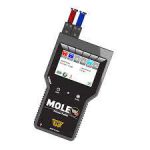 Adjustments can now be made to the fuel and air ratios, air flow, air recirculation and air balance. All of these factors are critical to the oven’s performance. This is accomplished by increasing or decreasing air and fuel mixtures, opening and closing the air ducts, increasing the air volume and changing the direction of the air flow.
Adjustments can now be made to the fuel and air ratios, air flow, air recirculation and air balance. All of these factors are critical to the oven’s performance. This is accomplished by increasing or decreasing air and fuel mixtures, opening and closing the air ducts, increasing the air volume and changing the direction of the air flow.
Sadly for many companies, this installation profiling will be the only time the oven is profiled and adjusted.
Many professional powder coaters profile their production runs for the following reasons.
- To limit product liability risks
- To reduce operating costs.
- To improve processing capacity
- To improve sales
Let’s candidly discuss each of these profiling issues in more detail.
Production profiling limits product liability risks
Risk management is a real concern for every business, and powder coating is no exception. The product liability of providing a poor quality powder coating finish could range from re-coating a few simple parts to the replacement of all products damaged by underexposure or overexposure to heat (a complete product recall).
The only way to totally manage risk is to be in total control. In turn, verification of control can only be certain when measurements are taken by proper testing equipment.
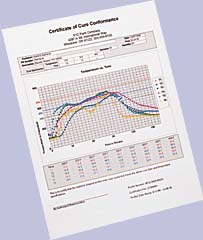 Quality is a matter of fact and does not happen by chance. The exposure that any company incurs by knowingly operating out of control when tools are available to guarantee control is senseless.
Quality is a matter of fact and does not happen by chance. The exposure that any company incurs by knowingly operating out of control when tools are available to guarantee control is senseless.
Click the link here for Suppliers of Oven Temperature Profiling Instruments, on PCO.
Production profiling reduces operating costs.
Scrap and rework are not the only costs of not knowing how your curing is progressing. Excessive energy costs are often overlooked and underquantified. That is why professional powder coating companies proactively manage their cure windows.
To fully appreciate the heat energy required to cure various coating materials on a variety of substrates the metal finisher must understand the relationship between temperature, time and mass.
The powder material cure requirements are outlined by the products technical data 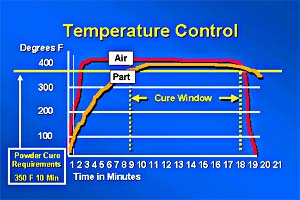 sheet. This information typically is given as time at temperature.
sheet. This information typically is given as time at temperature.
For example: 10 minutes at 350 degrees F.
However this does not mean the coating will always cure on all substrates exposed for 10 minutes total time in the cure oven at an atmospheric temperature setting of 350 degrees F. Thin metal parts will ramp to temperature much quicker than larger heavy parts.
Processing parts of heavy and light mass at the same time can further complicate variations in time, temperature and mass. Parts consisting of both heavy metal and light thin metal construction require special attention when attempting to establish the correct cure time and temperature.
If the coated workpiece is exposed to more heat than necessary for too long of a period of time, it may cause over-bake and a loss of some or all of the coatings properties. It will always cause a higher energy bill than was necessary.
On the other hand, if the substrate and the powder have not reached sufficient temperature for the proper amount of time, as specified by the powder manufacturer, the powder coating material will not cross-link at all. In either case failure of the finish will occur (which may or may not be immediately evident).
To proactively manage your cure window you must perform two different types of checks:
- Thermal profiling checks are made on the oven periodically (weekly or at minimum, monthly) to evaluate the evenness of the heat energy distribution within the oven.
2 Even more importantly, thermal profiling checks are made on the parts as they are being cured. A time-temperature-substrate mass relationship is determined by establishing a quantitative graph of time and temperature as the oven’s atmospheric environment transfers the heat energy to the substrate’s mass.
Scrap, rework and energy costs may be kept to a minimum by the routine collection of accurate thermal exposure data in an easy to understand report, typically in a form of an X-Y (time-temperature) chart. This data is commonly used as proof of conformance to end use customer that the finish was cured to the powder manufacturer’s time at temperature specification.
Remember, Cost + Profit = Price to the customer.
If costs go up, profits go down. Profits are simply money received in excess of costs.
Rejects eliminate more than Profits from the equation, never a good thing!
Rework Solution 1: Recoating
Finishing cost + refinishing cost = Lost $
Rework Solution 2: Stripping & Recoating
Finishing cost + stripping cost + refinishing cost = Lost $$
Rework Solution 3: Scrapping out the customers part
Finishing cost + part value + refinishing cost = Lost $$$
The cost associated with each of the above mentioned examples can be tracked over time. The exact cost of rejects over time is never a simple formula.
Many factors must be considered to realize the exact cost of failure, and in each case it will be different.
In some cases the result of failure is not always possible to calculate with a simple mathematical equation.Loss of good- will, as well as potential loss of repeat business is a serious concern.
Justification for the purchase of the proper equipment to insure total cure of the finish is an easy task when comparing the cost of such equipment to the high cost of failure.
It is easy to see how the professional powder finishers’ ability to proactively control their cure windows gives them a significant cost savings edge over other companies.
Production profiling improves processing capacity.
Confidence and control offered by knowing what is happening inside the cure oven will allow processing personnel to eliminate “trial and error” sample runs. The more time saved on a production run means that much more time is available for other production runs. This in turn translates into a longer time before a new oven or addition will be necessary for meeting more demanding production schedules as a result of increased business.
Production Profiling improves sales.
Total Quality Management (TQM) and quality driven management systems such as ISO 9000, QS-9000 and Community European (CE) marking have redefined the meaning of quality partnerships.
Many powder coaters have begun profiling all of their production runs, not only to reduce their product liability risks and reduce their operating costs, but also to send quality documents along with all of their shipments. This proves quality to their existing customers by helping to ensure their long-term loyalty.
Manufacturing companies are sure to partner with finishing companies that have solid control systems. Quality control tools are an essential investment in retaining customers not simply an expense. Those who say what they do, do what they say, and are able to prove it, will prevail over those who pretend to be in control. These companies’ sales people are using this 100% quality documentation as a way to beat their competitors. They are capitalizing on every opportunity to take their competitors’ customers and impress them with their quality system and documentation.
Additionally new developments in low temperature powder curing have opened doors of opportunity for powder coating. Current applications of glass, wood and manufactured fiberboard are growing in popularity.
When applying powder coating to MDF wood, high temperature plastics and composite materials temperature control is critical. The substrate materials composition may breakdown at a temperature very close to the coatings cure temperature. This thermal breakdown limitation on various nonmetallic substrates has limited the use of powder coating materials for many years. (see article Powder Coating Wood, Plastic & Glass)
There are many more powder formulations available now for cure at lower temperatures and the use, control and selection of low temperature powders is growing each year. These new application customers will be won by those powder coaters that have the equipment and knowledge that is necessary to guarantee the successful processing of the customer’s parts in these new tighter operating and cure window.
In Conclusion: Don’t leave quality to chance!
It is easy to see why many powder coaters profile their cure oven(s) regularly. The reduction in product liability risks, the operating cost savings, the production capacity increases and the sales improvement opportunities are compelling reasons to profile your production runs. Control is essential to any successful production operation. Without complete data and accurate information, quality is just a guess.
Acknowledgement:
Special thanks to Electronic Controls Design, Milwaukie, OR, for their contribution to this article.
ECD is a pioneer in the design, development, and manufacture of advanced thermal profiling systems and software used to monitor and analyze process temperatures in various industries.
See also: Oven Temperature Profiling Instruments Suppliers – PCO
Testing Instruments Suppliers – PCO
Powder Coaters Corner/Hot to Powder Coat – PCO
